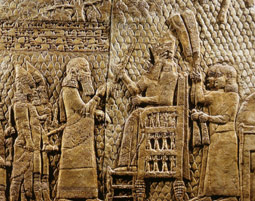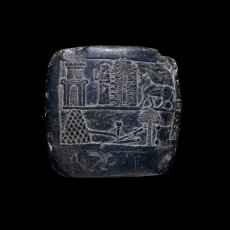Esarhaddon, king of Assyria (681–669)
The son of the notorious Sennacherib PGP and the father of the learned Assurbanipal, this Assyrian king is today far less known than either his father who famously besieged Jerusalem or his son, the creator of antiquity's largest library. But Esarhaddon, despite suffering from his fragile health, ruled Assyria with an iron hand and his political decisions influenced the fate of people from Egypt PGP to Iran.
Fighting for the crown

King Sennacherib and his crown prince Arda-Mullissi after the battle of Lachish in 701 BC; detail from the stone decoration of Sennacherib's palace in Nineveh (BM ANE 124911-3). Photo by Karen Radner. View large image.
Esarhaddon became king of Assyria against all odds, despite the fact that his father Sennacherib (704-681 BC) had made him crown prince TT in 679. However, he had not been the first choice. In order to have Esarhaddon installed as crown prince, Sennacherib first had to dismiss his son Arda-Mullissi PGP , who had been crown prince and heir apparent to the Assyrian empire for well over a dozen years. Why Sennacherib did this, we do not know. Despite the fact that Arda-Mullissi had to swear loyalty to his younger brother, he strongly opposed his elevation and tried to get Sennacherib to revoke the appointment. The king did not comply, although the new heir was sent into exile for his own protection. Sennacherib does not seem to have realised just how much his decision to back Esarhaddon's promotion endangered his own life, for Arda-Mullissi was allowed to stay in his father's closest proximity, where he continued to plot. In 681, Arda-Mullissi and one of his brothers stabbed Sennacherib to death, a deed that caused a stir all over the Near East. Yet the aftermath of the murder saw friction between Arda-Mullissi and his conspirators; his accession to the throne was delayed and ultimately never took place at all. Assyria was in chaos when Esarhaddon, returning from exile with a small army, marched towards the heartland of the empire. He managed to drive out the murderers of Sennacherib and, two months after the assassination, he became king of Assyria.
These bloody events shaped the new king profoundly. Esarhaddon ordered all conspirators and political enemies within reach to be killed; yet he could not touch the leader of the conspiracy. Arda-Mullissi had found asylum in Urarṭu PGP , Assyria's northern neighbour in Anatolia and its long-standing arch enemy. At that time, chances were that Arda-Mullissi still might become king and in that event, the Urartian king could reasonably expect to gain substantial influence over Assyria. In the meantime, Esarhaddon made an effort to ensure that his brother had no powerful allies at home, should he ever try to stage a coup d'etat from his exile: officials throughout the country who were suspected of entertaining sympathy for the enemy faction were replaced. To give but one example, the entire security staff at the royal palaces of Nineveh PGP and Kalhu PGP was dismissed - not sent into retirement but executed. Henceforth, Esarhaddon met his environs as a rule with overwhelming distrust. Routinely, he sought to establish by means of divination whether certain courtiers, officials or even members of the royal family wished him ill or to actively do him harm.
A successful king

Stone monument commemorating Esarhaddon's rebuilding of Babylon, showing the king worshipping the symbol of the supreme god Aššur at the top left. © The British Museum. View large image on the British Museum's website.
Esarhaddon proved himself a successful regent who consolidated his kingship and efficiently prevented segregation and territorial losses. Vassals, who had thought Assyria weakened and had tried to benefit from this, had to come to the painful realisation that Esarhaddon fully controlled his governors and his army and was able to take revenge for treason just as his predecessors had done. As a consequence, the vassal kingdoms of Sidon PGP (on the Phoenician coast) and Šubria PGP (in Anatolia) were conquered and turned into Assyrian provinces. The completion of a peace treaty with Elam PGP , Assyria's long-standing rival in Iran, in 674 BC must be seen as a skilful political manoeuvre. The securing of the eastern border provided Assyria with its first chance ever to exploit the power vacuum in Egypt to its own advantage. Assyria's first invasion of Egypt, however, resulted in a hasty retreat after defeat by Taharqa PGP , the ruler of Nubia who had proclaimed himself Pharaoh. But in 671 Egypt was conquered and became an Assyrian vassal state.
Esarhaddon's illness

Urad-Gula's letter to Esarhaddon (SAA 10: 315); photo from R. Mattila (ed.), Nineveh 612: the glory and fall of the Assyrian empire (Helsinki, 1995), 151. View large image.
Despite these successes, Esarhaddon was encreasingly hampered by his poor physical condition. He was constantly struck with illness, mostly rather severe. For days he withdrew to his sleeping quarters and refused food, drink and, most disturbingly, any human company. The death of his beloved wife Ešarra-hamat in 673 BC may well have further damaged his already fragile health. For the all-powerful king of Assyria, this situation was bizarre. Esarhaddon's counsellors witnessed his deterioration first with apprehension and then with increasing objections, but of course they were in no position to actually change this state of affairs. It is testament to Assyria's sound administrative structure that the country could take the king's continuing inability to act his part. It is easy to muster considerable sympathy for Esarhaddon, whose symptoms were indeed rather alarming. As we know from the correspondence left by the royal physicians and exorcists, his days were governed by spells of fever and dizziness, violent fits of vomiting, diarrhoea and painful earaches. Depressions and fear of impending death were a constant in his life. In addition, he was disfigured by a permanent skin rash that covered large parts of his body and especially his face. In one letter, the king's personal physician - certainly a medical professional at the very top of his league - was forced to confess his ultimate inability to help the king: "My lord, the king, keeps telling me: 'Why do you not identify the nature of my disease and find a cure?' As I have already told the king in person, his symptoms cannot be classified." (SAA 10: 315). It is not entirely clear whether the sickly Esarhaddon contracted one illness after the other or, as would seem more likely, suffered from the afflictions of a chronic disease that never went away. Be that as it may, in a society that saw illness as a divine punishment, a king who was constantly confined to the sick bed could not expect much sympathy and understanding. He could, however, reasonably presume that his subjects saw his affliction at the very least as an indication that the gods lacked goodwill towards their ruler, if not as the fruit of divine wrath, incurred by committing some heinous crime. Therefore, the king's condition needed to be hidden from the public by all means possible. That this was at all feasible was very much facilitated by the ancient tradition that whoever came before the king had to be veiled and on their knees.
Power sharing with his sons
Because of his failing health, Esarhaddon saw himself permanently in death's clutches. This alone made it necessary to provide for his succession: who would be king after him? There were a great many possible candidates; he himself had fathered at least 18 children. At one point, a son called Sin-nadin-apli PGP was deemed a suitable candidate, as demonstrated by a extispicy query addressed to the sungod (SAA 4: 149). However, it was Assurbanipal who was elevated to the rank of crown prince of Assyria in 672 BC at the same time that his elder brother Šamaš-šumu-ukin PGP was declared crown prince of Babylon. Subsequently, both crown princes were deeply involved in matters of political and cultic importance. Such a division of power must have appealed to all those who wished to see the sick king's burden lightened: it seems that a socially acceptable way of coping with an unpleasant and dangerous situation had been found.
In 669, Esarhaddon set out for a campaign against Egypt, which had risen in rebellion. He died on the way to the Nile. As far as we know, his death was natural and unexpected. Thus ended Esarhaddon's reign and, as planned, Assurbanipal ascended to the Assyrian throne, while his brother Šamaš-šumu-ukin became king of Babylon.
Further reading
- Leichty, 'Esarhaddon, king of Assyria', 1995.
- Parpola, Letters from Assyrian scholars, IIA, 1971.
- Parpola, Letters from Assyrian scholars, 1970-1983.
- Porter, Images, power, and politics, 1993
- Radner, 'The Trials of Esarhaddon: The Conspiracy of 670 BC', 2007
Content last modified: 17 Apr 2024.
Karen Radner
Karen Radner, 'Esarhaddon, king of Assyria (681–669)', Knowledge and Power, Higher Education Academy, 2024 [http://oracc.museum.upenn.edu/saao/knpp/essentials/esarhaddon/]